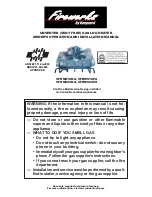
Because of the large amounts of water that can
condense, it is very important that a drain pan be
installed under the water heater (refer to Figure 10).
Under no circumstances is the manufacturer to be
held liable for any water damage in connection with
this water heater. If the problem persists and water
continues to drip after the water heater has heated
up, check all of the plumbing connections to make
sure they are not leaking.
Water Heater Tank
Drain a pail of water through the drain valve at least
once a year. This will remove excess sediment from
the bottom of the tank. If allowed to accumulate, this
sediment will reduce the efficiency and the life of the
tank.
Temperature and Pressure-Relief Valve
Manually operate the temperature and pressure-
relief valve at least once a year, standing clear of
the outlet to avoid being burned. Lift and release
the operating lever on the valve to make it operate
freely. If, after manually operating the valve, it fails to
completely reset itself and continues to discharge
water, replace it with a new one.
Venting System Inspection
The venting system must be thoroughly inspected
once a year. Check the area where the water heater
is located to make sure that there is enough clean
combustion and ventilation air. Remove any possible
obstructions that would prevent proper air circulation
and venting. Check the venting system to make sure
that all of the connections are securely fastened and
that all of the joints are properly sealed. If any part of
the venting system is damaged, it must be replaced
by a qualified service technician.
Anode
This water heater is equipped with dual anode
rods that are designed to prolong the life of the
glass-lined tank. The anodes are slowly consumed,
protecting the glass-lined tank from corrosion. The
anodes should be checked every two (2) years. If
more than half of either anode has been consumed,
it should be replaced. Instructions on how to change
the anodes can be obtained from the manufacturer.
The life expectancy of the water heater is reduced
where a water softener is introduced to fight hard
water, because the sodium salts added by a
softener make this water extremely conductive. In
these conditions, the anodes are consumed more
rapidly and should be verified every year. In cer-
tain water conditions, the anodes will react with the
water, producing discoloured or smelly water. The
most common complaint is hot water that smells
like rotten eggs. This phenomenon is the result
of the reaction between the anode and hydrogen
sulfide gas dissolved in the water, which occurs fre-
quently in well systems. This problem can usually be
eliminated or reduced by changing the anodes to a
type more suitable for these conditions (aluminum
anode) and by chlorinating the water heater and
plumbing system. If the problem persists, special
filtration equipment may be required. Under no
circumstances should the anodes be removed from
the water heater on a permanent basis.
Removal of
the anodes will lead to premature failure of the
water heater and void the warranty.
Hydrogen gas can be produced in a hot water
system that has not been used for a long period
of time (generally two [2] weeks or more).
HYDROGEN GAS IS EXTREMELY FLAMMABLE
.
It is highly recommended to open the hot water
faucet in the kitchen for several minutes before
you use any electrical appliances connected to
the hot water system, such as a dishwasher or
washing machine. If hydrogen gas is present,
there will be an unusual sound, such as air escap-
ing through the pipe, as the hot water faucet is
opened. Do not smoke or introduce an open flame
near the faucet when it is opened.
Draining the Water Heater
To completely drain the water heater:
1) Turn off the power to the water heater.
2) Close the oil supply manual shut-off valve.
3) Close the cold water supply manual shut-off
valve.
4) Connect one end of a garden hose to the water
heater drain valve and put the other next to a
free-flowing drain.
6) Open the drain valve by inserting a flat head
screwdriver into the slot on the head of the drain
valve and turning the knob counterclockwise
.
7) Open a hot water faucet to allow air into the
system.
16
GENERAL MAINTENANCE
GENERAL MAINTENANCE
REPLACEMENT PARTS
WARNING
AVERTISSEMENT
DANGER
Man inst Oil -GI-IM001En-0211.indd 17
11-10-12 2:11 PM



































